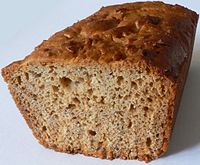Pain d'épices: Difference between revisions
Grammatical correction removed double "of" |
No edit summary |
||
| Line 3: | Line 3: | ||
''Pain d'épices'' was a kind of [[sourdough]] without leavening; it was left in a wooden trough to rest in a cool place for months, during which the honeyed rye flour experienced a fermentation. When ready the dough was cooked in [[Mold (food)|moulds]]. The modern product rises instead with [[baking powder]], developed in the nineteenth century. |
''Pain d'épices'' was a kind of [[sourdough]] without leavening; it was left in a wooden trough to rest in a cool place for months, during which the honeyed rye flour experienced a fermentation. When ready the dough was cooked in [[Mold (food)|moulds]]. The modern product rises instead with [[baking powder]], developed in the nineteenth century. |
||
now used in egland as part of "afternoon tea " served with jam |
|||
==Notes== |
==Notes== |
||
{{reflist}} |
{{reflist}} |
||
Revision as of 12:23, 2 September 2010

Pain d'épices ("spice-bread"), sometimes loosely translated as gingerbread, is a French cake whose ingredients, according to the Dictionnaire de l'académie française (1694), are "rye flour, honey and spices"[1] (today including aniseed but not traditionally ginger).[2] According to Maguelonne Toussaint-Samat, the commercial production of pain d'épices was a specialty of Reims, made to a recipe of a pastry-cook from Bourges, and given éclat by the taste for it of Charles VII, "King of Bourges" and his mistress Agnes Sorel. The honey used was the dark buckwheat honey of Brittany. In 1571 the Corporation of Spice-Bread Makers of Reims were chartered separately from the pastry-cooks; in 1596 the Parisian makers of pain d'épices were given their charter, too. The pain d'épices of Dijon outpaced its older competitors in the Napoleonic era. In Alsace, a considerable tradition of pain d'épices incorporates a pinch of cinnamon.
Pain d'épices was a kind of sourdough without leavening; it was left in a wooden trough to rest in a cool place for months, during which the honeyed rye flour experienced a fermentation. When ready the dough was cooked in moulds. The modern product rises instead with baking powder, developed in the nineteenth century. now used in egland as part of "afternoon tea " served with jam
Notes
